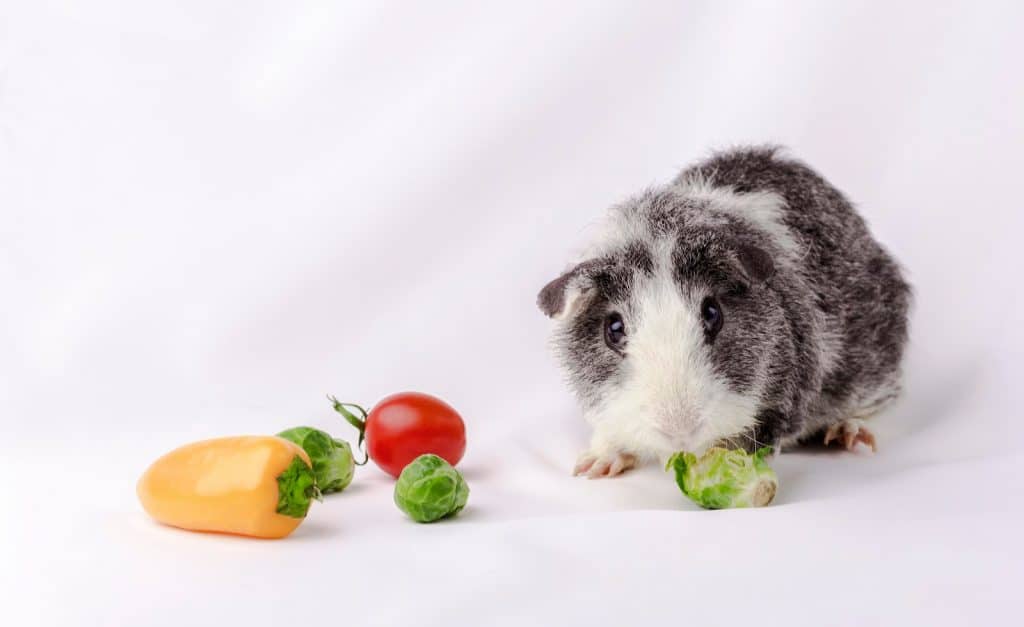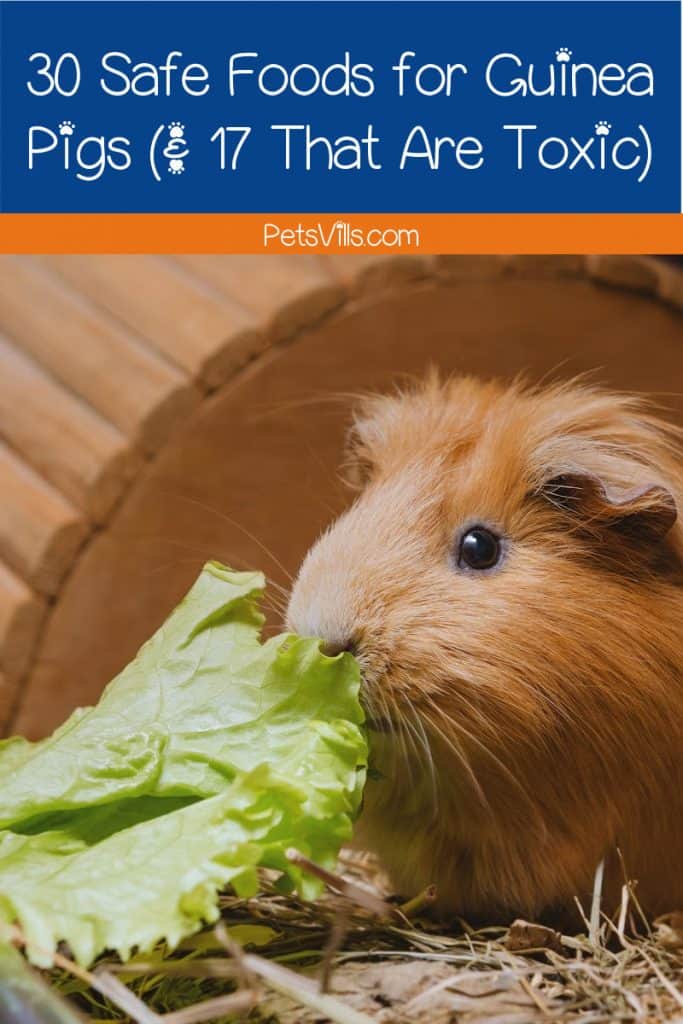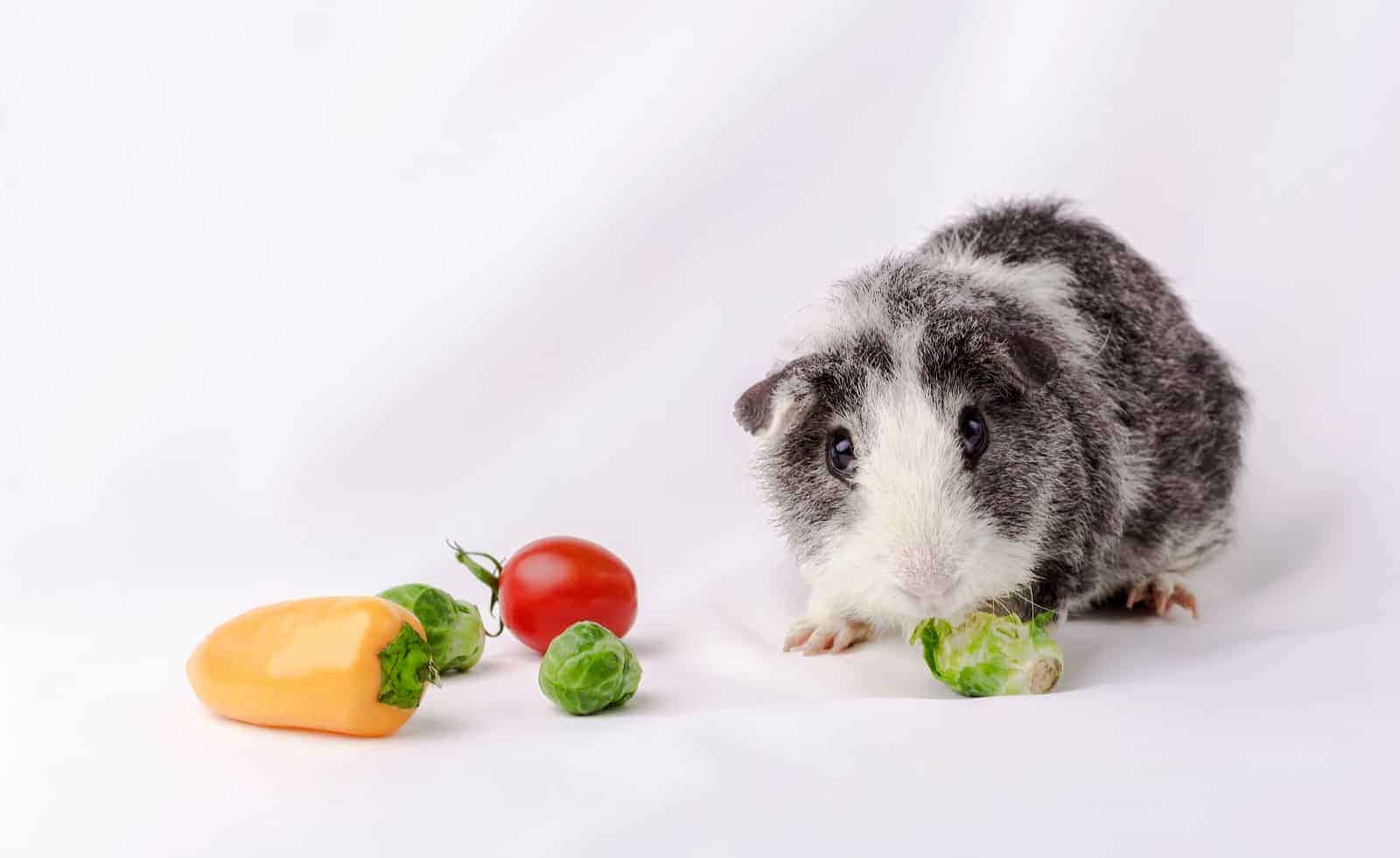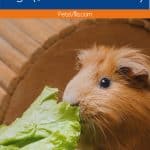If you’re looking for safe guinea pig foods to add to your cavy’s diet, we’ve got you covered!
Below, you’ll find a robust list of fruits, veggies, and other essentials that guinea pigs can eat (along with how often they can have them).
We’ll also go over some of the worst guinea pig foods that you should NEVER feed them!
Let’s dive in!
Check: Can Guinea Pigs Eat Cooked Broccoli?
What Should You Feed Your Guinea Pig?
Guinea pigs are herbivores, meaning they only eat “things that need photosynthesis to live,” such as vegetables, fruits, grasses, and bulbs.
In the wild, a guinea pig’s diet mainly consists of bark, grasses, hay, herbs, plants, seeds, and twigs.
Domestically, it is recommended that about 80% of a guinea pig’s diet comes from hay, 10% comes from guinea pig pellet food, and the remaining 10% from fresh fruits and vegetables.
Let’s look at that a bit more, then we’ll go over the list of the best guinea pig foods.
Hay–
Guinea pigs require an unlimited supply of fresh hay every day. In fact, this is easily your biggest cavy food expense.
We covered this quite a bit in “Can Guinea Pigs Eat Grass Instead of Hay,” so check that out for the safest types of hay and other recommendations.
Pellets–
Guinea pigs should be given about 1/8th cup of pellet food per day. Just make sure you’re choosing pellets made for cavies and not rabbits.
While they may look the same, guinea pig pellets have added nutrients, like vitamin C, that bunnies don’t really need.
Now, what fruits can guinea pigs eat?
Safe Fresh fruits and vegetables–
Your guinea pig should eat about 1 cup of veggies/fruits (far more veggies than fruits, though) each day.
When I make a guinea pig salad I start with about two leaves of lettuce from the list below.
Then I add in three different veggies from the “frequently” or “occasionally” list. I finish it off with a piece of fruit from one of the lists.
Now that we’ve covered the basics, let’s check out that list of safe guinea pig foods.
READ MORE: Can Guinea Pigs Eat Tomatoes?
List of Safe Guinea Pig Foods: Daily and Weekly Diet

I’ve broken down this list into foods that are safe to feed daily, frequently, and occasionally. Try to mix things up so that your cavy doesn’t get bored.
Believe me, it happens! My guinea pigs went on a Romaine strike for weeks because they were just so tired of it.
Daily-
- Broccoli– Raw broccoli only- Guinea pigs can eat all parts including stems and leaves.
- Endive– Rich in vitamins and minerals- Low in sugar.
- Green and/or red leaf lettuce– Good source of calcium & Vitamin C. With all lettuces, serve about 1-2 leaves.
- Kale– Packed with fiber and vitamins. Check “Is Kale Good for Guinea Pigs?”
- Radicchio– Great source of fiber, minerals and vitamins.
- Romaine lettuce- One of the best vegetables for guinea pigs- Contains a good amount of Vitamins A, B6 and C, as well as iron and potassium,
Frequently (2-4 times per week)-
- Arugula Lettuce– Very high in calcium. Stick to 1-2 leaves.
- Bell peppers– Serve 1 slice of green and/or yellow peppers since the orange and red ones are higher in sugar.
- Blueberries– Loaded with antioxidants, but also high in sugar- Serve 1-2 berries.
- Carrots– Rich source of beta carotene- Serve 1-2 sticks.
- Cucumber– Ok to leave the skin and seeds intact. Contains Vitamins C & K, as well as potassium- Serve 1 slice.
- Green beans- Raw green beans only- Good source of Vitamin C- Serve 1-2 beans.
- Peas– (snap, snow and sugar)- Ok to include the pods- Contains calcium, Vitamin C and phosphorus- Serve 1-2 pods.
- Squash– (summer and winter)- Leave the skin on as that is where most of the nutrients are- Serve small slices or cubes.
- Zucchini– High in Vitamin C- Low in salt and sugar- Serve small slices or cubes.
Occasionally (1-2 times per week)-
- Apples– High in fiber, but also high in sugar- Serve 1-2 small pieces, remove seeds.
- Dandelions– Both the yellow flower and the stalk. Only pick from your yard if you don’t use chemical weeders. Wash thoroughly.
- Grapes– Great source of Vitamin C- Serve 1-2 grapes.
- Honeydew– Remove the seeds as they are a choking hazard- Good amount of Vitamin C and potassium, but also high in sugar- Serve 1 slice.
- Kiwi– Rich source of fiber, potassium and Vitamin C- Contains sugar- A bit acidic- Serve 1 slice.
- Oranges– Excellent source of Vitamin C. Serve 1/4 per piggy. Remove seeds.
- Peaches– Contains potassium and Vitamin C, but also high in sugar- Serve 1 slice. Pits are HIGHLY toxic, so remove them.
- Spinach– High in Vitamin C and low in sugar- Contains oxalic acids- Serve 1-2 leaves.
- Watercress– High in Vitamin C, but also high in calcium- Serve 1 cup.
- Watermelon– Can eat the flesh and the rind- High in Vitamins A & C- Serve 1 small slice, without the seeds.
Rare Treats (Once a Month)
- Bananas– High in sugar and can cause gas, but a good source of calcium. Serve ½-inch slice.
- Carrot tops– while carrots themselves are a “frequent” food, the green tops should be an occasional treat.
- Cherries– just make sure to remove the pits.
- Peppermint (fresh herb)– Many piggies love it, but some REALLY hate it, so serve it on its own. Otherwise, they’ll reject the rest of the salad.
- Sweet potato– A good Thanksgiving treat for guinea pigs.
You’ll notice that the daily list of safe guinea pig foods is fairly short, but there’s still plenty to work with.
Like I said above, I use lettuce as a base, then I rotate through a selection of the other fruits and veggies to keep things interesting.
Check: Can Guinea Pigs Eat Radishes?
Guinea Pig Diet Feeding Chart
Below is a helpful guinea pig food chart that tells you what you need to feed your guinea pigs.
This chart was sourced from (http://happycavy.com/what-we-eat/) and is a great resource to check out.
I also use this chart to help me figure out the ratio of fruits to veggies to feed my piggies.
Harmful and Toxic Foods for Guinea Pigs
There are certain foods that you shouldn’t feed to your guinea pig. This is because these foods are either difficult to digest, are high in fat and/or sugar, have no nutritional value and/or are toxic to guinea pigs.
- Avocado– The skin is toxic to guinea pigs and the inside has a high-fat content.
- Bread– Bread is a type of processed food, which causes problems for a guinea pig’s digestive system.
- Cabbage– Cabbage is a cruciferous vegetable, which can cause bloating and gas in guinea pigs.
- Caffeine (chocolate, coffee, soda, etc.)- High in sugar.
- Coconut– High in fat content.
- Dairy products (milk, cheese, ice cream, etc.)- Guinea pigs are lactose intolerant.
- Garlic– Toxic to guinea pigs.
- Iceberg lettuce– While not toxic, it has high water content and no nutritional value.
- Meat– A guinea pig’s digestive system is not designed to consume meat.
- Mushrooms– Wild mushrooms are toxic to guinea pigs, while other types of mushrooms, like portobello, have no nutritional value.
- Nuts & seeds- High-fat content.
- Olives– High in fat, sodium and water content.
- Onions– Contains the compounds disulfides and thiosulphates, which are both toxic to guinea pigs.
- Peanut butter– High in calories, fat and salt.
- Pickles– Too acidic for guinea pigs.
- Potatoes– Green and sprouted potatoes can be toxic to guinea pigs.
- Rhubarb– The leaves and stalks are toxic to guinea pigs.
Related: Can Guinea Pigs Eat Yams?
Guinea Pig’s Diet Other Questions
What Are Good Treats For Guinea Pigs?
Treats are great ways to bond with and train your guinea pig. However, a lot of store-bought guinea pig treats are unhealthy and calorific.
It’s best to feed unhealthy store-bought treats to your guinea pigs in moderation, perhaps a couple at a time and only around once or twice a week.
When looking for more healthy store-bought treats for your pet, look for the best guinea pig treats that contain no added sugar, are free of artificial flavors, colors, and preservatives, and consist of more natural ingredients, such as Timothy hay.
If you’d rather your guinea pig didn’t eat any store-bought treats or you’re looking for a healthy alternative you can feed more regularly, then vegetables and leafy greens are great snacks for your guinea pigs.
Good examples include kale, broccoli, cabbage, spinach, and green beans.
You can also feed your guinea pigs fruits. However, due to their high sugar content, fruits should only be fed occasionally.
Remember to wash your fruit and make sure it’s clean before giving it to your guinea pig.
CHECK: Can Guinea Pigs Eat Leeks?
Do Guinea Pigs Need Chew Toys?
Guinea pigs have teeth that are constantly growing throughout their lives. To prevent dental problems from occurring, your guinea pig’s teeth need to be worn down.
Chew toys are a must for guinea pigs as they help file their teeth down to stop them from becoming overly long.
The best chew toys for guinea pigs are made out of safe wood. Wood is efficient at wearing down your guinea pig’s teeth when they gnaw on it.
Here are a few of the best chew toys for your guinea pig:
Natural Willow Sticks
These willow sticks from Niteangel are perfect chew toys for your guinea pigs.
They’re made from 100% willow branches, making them completely safe for your guinea pig to gnaw on.
These willow sticks can be bought on Amazon here.
As well as being great for wearing down your guinea pig’s teeth, these willow sticks are good boredom breakers to prevent your pet from becoming anxious!
The sticks measure around 5 to 6 inches long, which means they’re large enough for your guinea pig and should last quite a while.
Organic Apple Sticks Chew Toys With Grass Cakes
This chew toy from AUOKER is made from apple sticks and grass. It’s free from pesticides, dyes, and artificial additives and can be found on Amazon here.
Apple sticks are effective at wearing down your guinea pig’s teeth. They also contain roughage for healthy digestion!
This chew toy comes with a metal hook so you can hang it onto your guinea pig’s cage easily.
Kaytee Perfect Chews
This chew toy from Kaytee is a vibrant and colorful addition to your guinea pig’s cage.
I was surprised how affordable these Kaytee Perfect Chews are on Amazon.
It comes with a metal hook to make it easy to hang onto your guinea pig’s cage.
The chews are made from natural and pet safe materials, so your guinea pig can nibble on them for as long as they want!
This chew toy is ideal for wearing down your guinea pig’s teeth and it will also brighten up your guinea pig’s cage!
My Guinea Pig is Eating Their Poop – Is This Normal?
This is completely normal for your guinea pig and is a process called coprophagy. It’s an important part of their health and how they digest their food.
Guineas pigs have two types of poo.
The poo they eat is called ‘caecotrophs’ and is still full of vitamins and proteins. By eating this type of poo (technically it’s not actually poo, it’s just from the same place and looks similar) they are trying to get all the goodness out of their food.
The poo they eat is usually hard dry pellets and can be cleaned up and thrown away when you spot clean or full clean your guinea pigs cage.
Do Guinea Pigs Need Vitamin C?
Guinea pigs don’t produce much vitamin C so it is important to feed them a range of selection of vegetables, fruits, and high-quality pelleted food. This should meet the requirements for an average guinea pig’s vitamin C intake.
If your guinea pig doesn’t get enough vitamin C (which is quite common in guinea pigs) they can get a condition called scurvy.
Systems of a vitamin C deficiency:
- Low levels of energy
- Swollen joints that can stop them from walking
- Spots
- Small wounds might not be able to heal or bleed more than normal
- Rough fur/hair coat
- Loss of appetite
- Weight loss
- Diarrhea
It’s important to treat scurvy as if left untreated it can lead to death. Luckily it is easy to treat by upping their vitamin C intake.
You can do this by feeding them fruit and veg that is high in vitamin C and also by giving them vitamin C supplements.
Vitamin C tablets and crystals that you can sprinkle on top of food are available. It’s best not to put vitamin C tablets or the sprinkles in their drink as some guinea pigs don’t like the taste and will stop drinking.
What Other Household Foods and Drinks Can Guinea Pigs Consume?
Other than safe fruits and vegetables, there aren’t really any other household foods guinea pigs can eat.
Guinea pigs should never drink anything other than clean water.
Cheese
Guinea pigs cannot eat cheese, not even in small amounts. Guinea pigs lack the enzymes in their digestive tract to process any type of dairy.
Guinea Pigs Gi tract is not meant for anything but plants
Bread
Guinea pigs can eat bread, but only very occasionally. The bread offers no nutritional value to your guinea pig and could cause bloating. There are much healthier snacks to feed your guinea pig.
Meat
Guinea pigs are herbivores and live solely on plant matter, which means they do not need any meat in their diet. You shouldn’t feed your guinea pig any type of meat as they cannot process it.
Guinea Pigs Gi tract is not meant for anything but plants
Brazil Nuts
Guinea pigs should not be fed nuts, including Brazil nuts, as they contain a lot of fat, as well as other things that are bad for them.
Guinea Pigs Gi tract is not meant for anything but plants
Milk
Guinea pigs cannot drink or consume milk. Guinea pigs are unable to process milk or any dairy products as they lack the digestive enzymes to do so.
READ MORE: Can Guinea Pigs Have Edamame?
Guinea Pig’s Diet-Related Health Problems
If you don’t feed your guinea pig a well-balanced diet, then there are various health problems that can occur.
Guinea pigs need a lot of vitamin C in their diet as they are unable to make it themselves. Vitamin C comes from vegetables/leafy greens and high-quality guinea pig pellets.
A lack of vitamin C in your guinea pig’s diet can cause scurvy.
Symptoms of scurvy in guinea pigs include:
- Weight loss
- Reduced appetite or reluctance to eat
- Rough coat
- Bruised skin
- Bleeding of the gums or skin
- Weakness
- Stiff movements or “bunny hop” walk
- Loose stools
- Sore Joints
- Swollen legs or ribs
Guinea pigs also need a high amount of fiber in their diets. Fiber comes from vegetables, fruits, and hay.
Fiber is crucial for keeping your guinea pig’s digestive system healthy and working properly. Fiber also helps with dental health.
Without enough fiber in their diets, guinea pigs can develop gastrointestinal ileus. This is when the digestive tract slows down and doesn’t work efficiently.
Signs of gastrointestinal ileus include:
- Reduced appetite
- Lethargy
- A bloated or swollen stomach
- Infrequent or smaller stools
A diet that’s high in fat can cause obesity in guinea pigs, so you should avoid feeding your guinea pig too many unhealthy and calorific treats.
You should also ensure your guinea pig’s nuggets/pellets do not contain high amounts of fat.
Obese guinea pigs are more likely to develop heart, liver, and respiratory disease.
Can guinea pigs eat eggs?
No, guinea pigs cannot eat eggs. Guinea pigs are unable to process dairy and can make them ill.
Can guinea pigs eat garlic?
No. Garlic is incredibly toxic to guinea pigs and can be extremely dangerous for guinea pigs to consume.
Can I feed my guinea pig grass cuttings?
It’s tempting to feed your guinea pig the grass trimmings after you’ve mowed your lawn, but you shouldn’t. Grass cuttings/trimmings can cause digestive upset.
There you go! It’s far from a complete list of every safe fruit and veggie for cavies, but it will get you started.

Can you think of any safe guinea pig foods that I missed that your own cavy really loves? Share below!
Deanna is a passionate animal lover. She is the mom of several guinea pigs and sugar gliders.
When she’s not writing, Deanna loves listening to country music, or watching Dancing With The Stars.
Read her : Latest Articles
FIND HER ON: FACEBOOK and LINKEDIN and



Thank you for all of the wonderful info! Eggs though, are not dairy, and under “Eggs,” you call them dairy.